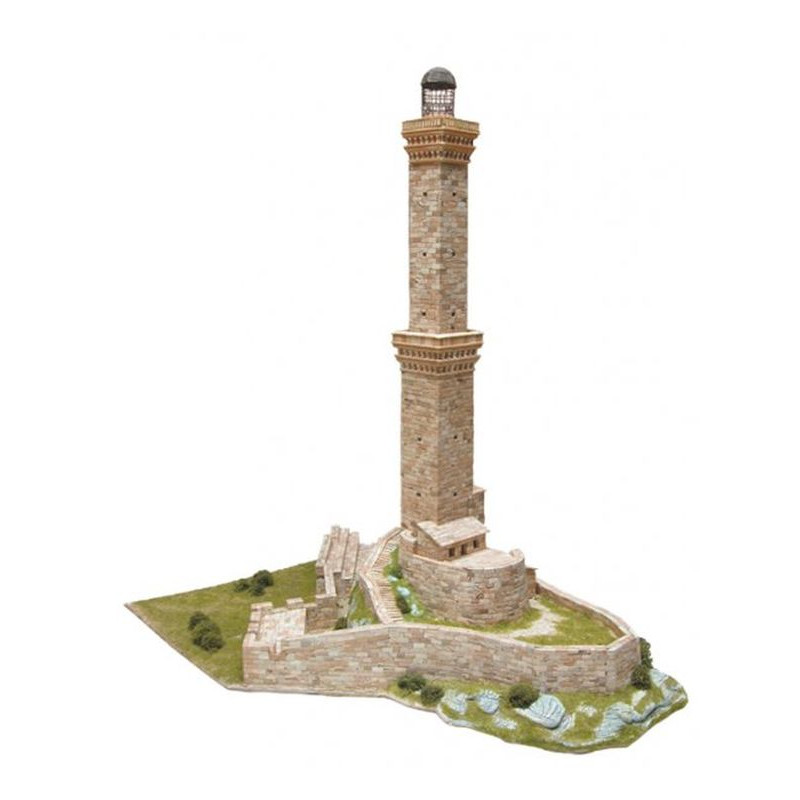Construction kits from Spanish company Aedes Ars are designed to construct reproductions of historical buildings of high cultural value such as castles, churches, bridges, lighthouses. Some of them have been cataloged as world heritage monuments. The construction materials used in the kits (alabaster brick, ceramic tile) are very similar to those used in the original buildings, and the quality and shapes and colors are based on the technology of the production process of the Aedes Ars company. Some kits include ceramic architectural elements (lintels, carvings, etc.), which reproduce with a high degree of detail the actual appearance of the various parts of the original construction. The construction of the kit starts with gluing the cardboard skeleton and then gluing the skeleton with alabaster bricks, ceramic tiles according to the included instructions. The constructions are designed for people from 12 years of age with a difficulty scale from 1 to 10, develop manual skills, spatial imagination and creativity. Constructing such a building can be a great family entertainment, and the finished model will arouse interest and admiration as well as will be a decorative element of our house.
Genoa Lighthouse
The Genoa Lighthouse is located in the territory of the province of Genoa, Italy. It is one of the biggest tourist attractions of Genoa. The lighthouse stands on a 40-meter high rock and is 77 meters high. Its light can be seen from a distance of about 50 kilometers. There were more similar lighthouses in Genoa during the time of Christopher Columbus, but during the war with France, the Genoese destroyed their own towers by mistake in 1506. The lighthouse we can see today was rebuilt in 1563.
In the 8th century BC, below the castle hill (castrum), after finding a natural harbor protected from the wind, an inhabited settlement developed in the bay of Mandracciona, which enabled sailing activities.
The city of Genoa gradually grew around the castle hill and spread primarily to the west. The natural harbor remained protected by an old pier, still visible today.
According to an unofficial source, the first tower, not as high as the present one, but of similar design, was built in 1128. A document from the 11th century, which is one of the first chronicles of the newly created province of Genoa, gives information about the existence of a signal and observation tower, but does not give the exact date of its construction. The first lighthouse was probably installed in 1326 and appears on the cover design of the textbook "Salvatori del Porto."
In 1500, a new pier was built, an engineering work. Around 1513, the lighthouse was the center of negotiations for the French occupation as a control center for the land-sea connection. At the time, its light only helped sailors. In 1543, the structure was enlarged, using 200 tons of lime and 160 meters of stone quarried from the sea. An iron cross was also added to the dome.
In the 17th century, the structure was connected to the city walls as a defensive harbor barrier against storms.
The "Spider", whose light has a range of 27 nautical miles, is located at an altitude of 117 meters above sea level and is one of the most visited by tourists, since from the terrace of the second tower you can see the entire bay and the coast.
Lanterna di Genova is a symbol of the city and a postcard image of all Liguria.
Model specifications:
- Location: Italy / 12th century
- Scale: 1:160
- Number of elements: 4.300
- Degree of difficulty: 7,5/10
- Dimensions: 590 x 390 x 635 mm
For more information, photos and building instructions, please visit the manufacturer's website (tab above).
And, how to build the model ? See the example of similar builds from Aedes Ars:




